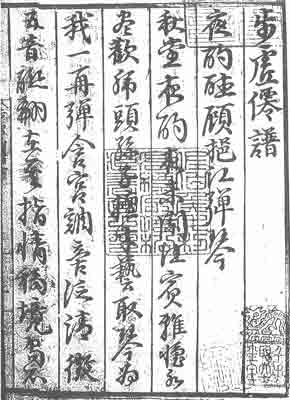|
T of C
Home |
My Work |
Hand- books |
Qin as Object |
Qin in Art |
Poetry / Song |
Hear, Watch |
Play Qin |
Analysis | History |
Ideo- logy |
Miscel- lanea |
More Info |
Personal | email me search me |
| Handbook List / BXXQ ToC | 網站目錄 |
|
Buxuxian Qinpu
Qin Handbook of the Strolling-in-Emptiness Immortal 1 |
步虛僊琴譜
ca. 1556 First page of the complete edition 2 |
 This handbook is mentioned by Van Gulik, who must have seen a copy, as he wrote:3
This handbook is mentioned by Van Gulik, who must have seen a copy, as he wrote:3
The title of the handbook certainly suggests its Daoist character. However, it is not clear what personal connection the title might have had to the compiler, Gu Yijiang.4
As with other mid-Ming dynasty handbooks, 31 of the 53 melodies seem to be variants of the same titles found in Shen Qi Mi Pu. However, its versions do not seem to be the same as those outlined in the comparative chart of melodies published in other 16th century handbooks.
Although the edition of this handbook in Qinqu Jicheng has only Folios Five and Six of the original six folios, there are complete editions available in Taiwan and, apparently, Japan.5 Of the 53 melodies in the complete edition, two are the earliest known versions:
¡Preface
by Zha Fuxi6
from Qinqu Jicheng, Vol. 3
Beijing, Zhonghua Shuju Chuban Faxing,7 1982
(This handbook), in the collection of the Music Research Department of the Art Research Institute,8 is a Ming print; an incomplete edition with only Folios Five and Six, altogether 15 pieces. (The complete edition has 53 pieces, none with lyrics.9)
According what is recorded in Yuguzhai Kao Cunqinpu, 10 this book was compiled in 1556 by Gu Yijiang, the whole book having nine folios. The Catalogue of the Naikaku Bunko (Library of the Cabinet) in Japan records the same information.11
Footnotes (Shorthand references are explained on a
separate page)
1.
Qin Handbook of the Strolling-in-Emptiness Immortal (步虛僊琴譜 Buxuxian Qinpu)
"僊 xian" is the same as "仙 xian": immortal. For 步虛 bu xu (treading the void) 16621 has no entry, but 5/334 does, first saying it is 道士唱經禮讚 Daoist singing classic ritual praises, quoting a poem by 李白 Li Bai (題隨州紫陽先生 Written on the Wall of Mr. Ziyang of Suizhou) that says, "喘息餐妙氣,步虛吟真聲。 Gasp out while consuming marvelous qi, chanting the genuine sounds." It then says, "指道家傳說中神仙的凌空步行 Refers to a Daoist saying about immortals wandering in the cold stratosphere". It then these entries: 16621.81-84:
- 步虛人 buxuren: a Daoist (reference 王昌齡 Wang Changling, Tang poet;)
- 16621.82 步虛子 bu xuzi: same as .81 (reference 儲光羲 Zhu Guangxi also a Tang poet; 16621.81 )
- 步虛詞 buxu ci: 樂府雜曲歌辭名 name of a Yuefu poem; 16621.83
- 步虛聲 buxu sheng: 謂道士誦經聲也 the sound of a Daoist chanting scripture; 16621.84.
- 步虛壇 buxu tan: an altar/terrace for such chanting
In various parts of the handbook itself the title is also referred to simply as 步虛僊譜 Buxuxian Pu. "Bu xu" is a term used in popular Daoist practices, but I have not yet found out in what way this is significant to the compiler of this handbook, Gu Yijiang.
Was it also called 步虛堂琴譜 Buxutang Qinpu? This is the title used in Lore of the Chinese Lute, by R. H. Van Gulik (Tokyo, Tuttle, 1940), "Chinese Literature on the Lute," p. 184. It is also compiled by Gu Yijiang in nine folios, with prefaces and an afterword by the same four people who wrote prefaces for the edition of Buxuxian Qinpu in Taiwan. The four are:
- 孫承恩 Sun Cheng'en (dated 1551; Bio/789: 1485 - 1565, from 松江 Songjiang, between Suzhou and Shanghai;
noted calligrapher and painter; see also 明詩綜 Mingshizong, ch.74), - 王挺 Wang Ting (undated; prob. not Bio/111: end of Ming, early Qing)
- 陳中州,號亢愓子 Chen Zhongzhou, nickname Kangtizi (1559; Bio/1365, from 青田 Qingtian, upriver from Wenzhou in S.E. Zhejiang)
- 王應侲 Wang Yingzhen (afterword; undated?; Bio/xxx but VG says Mingshizong, ch.51).
None have yet been translated.
(Return)
2.
Image
Copy made at the National Library, Taiwan
(Return)
3.
Content
See Van Gulik (op. cit p.184). As with other mid-Ming dynasty handbooks, 31 of the 53 melodies seem to be variants of the same titles found in Shen Qi Mi Pu. However, its versions do not seem to be the same as those outlined in the comparative chart of melodies published in other 16th century handbooks.
4.
Gu Yijiang 顧挹江
I have not found any biographical references for Gu, whose name means "Mr. Gu Who-bails-out-the-river". From the prefaces it seems that he was in the Jiangnan area, between Nanjing and Suzhou.
(Return)
5.
Complete editions of Buxuxian Qinpu
Zha Fuxi's preface mentions the its listing in the catalogue of the Naikaku Bunko in Tokyo, so presumably there is a copy in that library. There is definitely an edition in the National Libary, Taiwan - its Table of Contents is translated here).
(Return)
6.
查阜西 Zha Fuxi, edited by 吳釗 Wu Zhao
(Return)
8.
文化部藝術研究院音樂研究所; is it still at the Music Research Department?
(Return)
9.
Complete editions of Buxuxian Qinpu
The preface later mentions the catalogue of the Naikaku Bunko in Tokyo, so presumably there is a copy in that library. In addition, there is one in the National Libary, Taiwan (see its Table of Contents).
(Return)
10.
Yuguzhai Qinpu is dated 1855. Are they the same?
(Return)
11.
Naikaku Bunko 內閣文庫
(Return)
Return to the annotated handbook list or to the Guqin ToC.